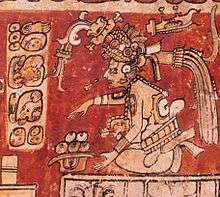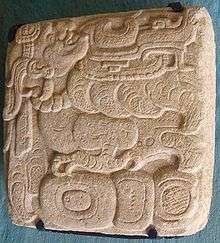Itzamna
Itzamna (Mayan pronunciation: [it͡samˈna]) was, in Maya mythology, the name of an upper god and creator deity thought to reside in the sky. Although little is known about him, scattered references are present in early-colonial Spanish reports (relaciones) and dictionaries. Twentieth-century Lacandon lore includes tales about a creator god (Nohochakyum or Hachakyum) who may be a late successor to him. In the pre-Spanish period, Itzamna, represented by the aged god D, was often depicted in books and in ceramic scenes derived from them.

Name

J. Eric S. Thompson originally interpreted the name Itzamna as "lizard house", team being a Yucatecan word for iguana and near meaning "house".[2] However, Thompson's translation has gradually been abandoned. While there is no consensus on the exact meaning of the name Itzamna, it may be significant that it is a root denoting all sorts of secretions (such as dew, sap, and semen) and also sorcery. The otherwise unattested, agentive form team could thus mean "asperser" or "sorcerer".[3] Although one finds God D's Classic name glyph commonly rendered as "Itzamnaaj", this reading still awaits confirmation.
Early colonial reports
The early colonial sources variously connect, and sometimes identify, Itzamna with Hunab Ku (an invisible high god), Kinich Ahau (the sun deity), and Yaxcocahmut (a bird of omen).
The most reliable source on Itzamna, Diego de Landa, mentions him several times in the framework of his description of the ritual year. In the month of Uo, a ritual aspersion of the books took place under invocation of Kinich Ahau Itzamna, "the first priest". In the month of Zip, Itzamna was invoked as one of the gods of medicine, and in the month of Mac, he was venerated by the very old on a par with the Chaacs, the rain deities. In the cycle of four years, one year was under the patronage of Itzamna.
Itzamna was an active creator god, as is shown by the following. Confirming Landa's description of the book ritual above, (Hun-)Itzamna is stated by Diego López de Cogolludo to have invented the priestly art of writing. According to this same author, Itzamna (now written Zamna) had been a sort of priest who divided the land of Yucatán and assigned names to all of its features. More generally, Itzamna was the creator of humankind, and also the father of Bacab (Francisco Hernández), a fourfold deity of the interior of the earth. In an alternative tradition, Itzamna begot thirteen sons with Ixchel, two of whom created the earth and humankind (Las Casas).
Pre-colonial era

In the New Year pages of the Dresden Codex, god D is given a role similar to that of Itzamna in Landa's description of these rituals. It is thus likely that in the Post-Classic codices, the aged god D represents Itzamna. The codical god D is very similar to the much earlier god D of Classic iconography.[4] By comparison with the early-colonial data above, however, Classic scenes are more suggestive of narrative traditions, at times subjecting god D to the actions of others: He can, for example, be shown clinging to the back of a peccary or a deer; held ready for sacrifice; or be shot at in his bird avatar.
High priest and ruler
God D is sometimes dressed as a high priest, and hieroglyphically identified as the god of rulership. Speaking generally, Classic iconography confirms god D's identity as an upper god, seated on his celestial throne while governing, among other things, the affairs of agriculture and the hunt.
Crust of the Earth: Caiman

On two of the Dresden Codex's very first pages, god D is shown within the maw of a caiman representing the earth; a case has been made for identifying the caiman as the deity's transformation (Thompson, Taube).
Itzam Cab Ain is believed to be his terrestrial aspect, meaning “Cayman of Earth Itzam” and assumes a prominent role in the narratives of creation in maya mythology, The gods used its body to make the earth after killing it. The myth begins with a cataclysm caused by the saurian after vomiting the fluid that floods the earth. Then, the gods decapitate the reptile to stop the flood. Later, the body of the lizard falls on the earth and on its four corners are placed the four world trees to raise and hold the sky that had collapsed.
Father of Bacab
Both god D and his avian manifestation sometimes show features of the Bacab (god N),[5] who, as mentioned above, appears to have been considered a son of Itzamna at the time of the Spanish conquest.
Aged tonsured maize god
Iconographically, god D can be considered an aged form of the tonsured maize god. Both deities are often shown together.
Principal Bird Deity

From the Late Postclassic Paris Codex back in time to the Pre-Classic San Bartolo murals, god D (Itzamna) has the so-called Principal Bird Deity - perhaps the Yaxcocahmut mentioned above - for a transformative shape (see figure). The bird often holds a bicephalous snake in its beak. Its head sometimes resembles that of a rain deity; at other times, it is more like that of a bird of prey, perhaps the laughing falcon believed to be a harbinger of rain.[6] The wings are repeatedly inscribed with the signs for "daylight" and "night", suggesting that the bird's flight could represent the unfolding of time. The San Bartolo murals have a Principal Bird Deity seated on top of each of four world trees, recalling the four world trees (together with a fifth, central tree) which, according to some of the early-colonial Chilam Balam books, were re-erected after the collapse of the sky. These world trees were associated with specific birds. Four world trees also appear in the Mexican Borgia Codex. The shooting of the Principal Bird deity is one of the main episodes of the Classic Period Hero Twins myth; but strong arguments plead against the Principal Bird Deity's equation with Vucub Caquix, a bird demon shot by the Popol Vuh Twins.
Human representatives
God D and his avian transformation could be represented by human beings. Various kings of Yaxchilan, Dos Pilas, and Naranjo had Itzamnaaj as part of their names or titles. On Palenque's Temple XIX platform, a dignitary presenting the king with his royal headband wears the Principal Bird Deity's headdress, while being referred to as Itzamnaaj. In his bird avatar, god D here appears as the creator god bestowing rulership on a king.
References
- Espinosa Díaz 2001, p.16.
- Thompson 1970: 209-233
- Freidel, Schele, Parker 1993: 411-413
- Taube 1992: 31-41
- Bassie-Sweet 2008: 137-139
- Bassie-Sweet 2008: 141-143
Bibliography
- Ferdinand Anders, Das Pantheon der Maya.
- Lawrence Bardawil, The Principal Bird Deity in Maya Art: An Iconographical Study of Form and Meaning (1976). www.mesoweb.com/pari/publications/RT03/PrincipalBirdDeity.pdf
- Karen Bassie-Sweet, Maya Sacred Geography and the Creator Deities. Norman 2008.
- Espinosa Díaz, Margarita (2001). "Creación y Destrucción en Toniná". Arqueología Mexicana (in Spanish). 9 (50): 16.
- Freidel, Schele, Parker, Maya Cosmos.
- Nicholas Hellmuth, Monsters and Men in Maya Art.
- Houston, Stuart, Taube, The Memory of Bones.
- Simon Martin and Nikolai Grube, Chronicle of the Maya Kings and Queens.
- David Stuart, The Inscriptions from Temple XIX at Palenque.
- Karl Taube, The Major Gods of Ancient Yucatan. 1992.
- Karl Taube, A Representation of the Principal Bird Deity in the Paris Codex.
- Eric Thompson, Maya History and Religion. Norman 1970.
- Alfred Tozzer, Landa's Relacion de las Cosas de Yucatan.
| Wikimedia Commons has media related to Itzamna. |